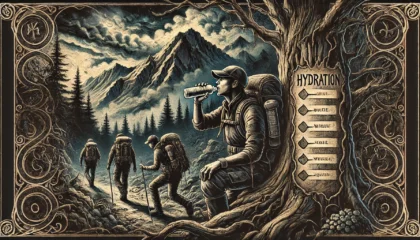Backpacking stoves are essential for cooking in the backcountry, but they can be expensive or bulky. Building your own DIY backpacking stove can be a cost-effective, lightweight, and efficient alternative. In this guide, we’ll explore different stove designs and how to construct one yourself using common materials.
[/vc_column_text][vc_column_text responsive_align=”left”]Why Make Your Own Backpacking Stove?
[/vc_column_text][vc_column_text responsive_align=”left”]- Cost Savings: Store-bought ultralight stoves can be expensive, whereas DIY options often cost just a few dollars.
- Customization: You can tailor the stove to your specific needs, whether for ultralight packing or better fuel efficiency.
- Simplicity: Many designs require minimal tools and effort to construct.
Types of DIY Backpacking Stoves
[/vc_column_text][vc_column_text responsive_align=”left”]There are several designs to choose from, each with its own benefits:
[/vc_column_text][vc_column_text responsive_align=”left”]1. Alcohol Stoves
[/vc_column_text][vc_column_text responsive_align=”left”]Alcohol stoves are popular for their simplicity and efficiency. They use denatured alcohol or similar fuels and are lightweight.
- Pros: Simple to make, lightweight, and reliable.
- Cons: Less heat output than gas stoves, not ideal for extreme cold.
Materials Needed:
- Aluminum cans (soda or energy drink cans work well)
- Utility knife or scissors
- Thumbtack or drill
- Ruler and marker
- Denatured alcohol
Steps to Build:
- Cut two aluminum can bottoms (about 1.5 inches tall).
- Punch small fuel holes around the edge of one piece.
- Insert the second piece into the first to create a tight fit.
- Fill the center with a small amount of alcohol and light it.
- Use a windscreen and pot stand for optimal efficiency.
Recommended Product:
For those who prefer a ready-made option, the REDCAMP Mini Alcohol Stove is a lightweight and efficient choice. It features an aluminum alloy stand and brass stove, with a base windscreen for stability. Weighing only 5 ounces, it’s ideal for backpacking.
[/vc_column_text][vc_column_text responsive_align=”left”]2. Wood Gasifier Stoves
[/vc_column_text][vc_column_text responsive_align=”left”]Wood gasifier stoves are efficient, burning wood to produce a clean, hot flame. They can be constructed from metal cans and are suitable for those who prefer using natural fuel sources.
- Pros: Uses free, natural fuel (sticks, twigs, etc.), no need to carry fuel.
- Cons: Slightly bulkier, requires some preparation to gather fuel.
[/vc_column_text][vc_column_text responsive_align=”left”]
Materials Needed:
- Large soup can or coffee can
- Smaller can (tuna or similar)
- Tin snips
- Drill or hole punch
- Insulation material (sand or ashes)
Steps to Build:
- Cut a hole near the bottom of the large can for the smaller can to fit inside as the fuel feed.
- Cut an opening at the top of the smaller can to allow airflow.
- Insert the smaller can into the larger can at an angle.
- Pack insulation material around the smaller can inside the large can.
- Place a pot stand on top and start with small sticks and twigs for fuel.
Recommended Reading:
For detailed instructions and designs, consider “The Amazing Wood-Gas Camping Stove: A Simple DIY Project” by Paul Andrulis. This guide provides step-by-step directions to build an efficient wood-gas stove.
[/vc_column_text][vc_column_text responsive_align=”left”]3. Tuna Can Stove (Simple Burner)
[/vc_column_text][vc_column_text responsive_align=”left”]One of the easiest designs, this stove is a great emergency option.
- Pros: Extremely easy to make, very lightweight.
- Cons: Short burn time, limited heat output.
Materials Needed:
- Empty tuna can
- Corrugated cardboard
- Wax or alcohol-based gel fuel
Steps to Build:
- Cut strips of cardboard and roll them into a tight coil to fit inside the tuna can.
- Pour melted wax or alcohol gel fuel over the cardboard.
- Light the fuel, and use a small pot stand for cooking.
Tips for Using DIY Stoves Safely
- Always use your stove on a flat, non-flammable surface.
- Have a windshield to improve efficiency and reduce heat loss.
- Test your stove before taking it into the wild.
- Carry extra fuel or a backup stove if necessary.
- Never use stoves inside a tent or in poorly ventilated areas.
Final Thoughts
Building a DIY backpacking stove is a fun and rewarding project that can enhance your outdoor adventures. Whether you prefer the simplicity of an alcohol stove or the efficiency of a rocket stove, making your own allows you to customize your gear to match your needs. With a little creativity, you can craft a lightweight and efficient stove perfect for your next trip into the wild.[/vc_column_text][/vc_column][/vc_row]


